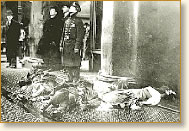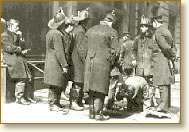|
Immigration in the Early 20th Century |
|
The Triangle Shirtwaist Company Fire, 1911
A majority of the immigrants that landed on America's shores made their way to
the tenement sections of the teeming cities of the Northeast. Often illiterate
and with a limited knowledge of English, they found jobs wherever they could,
often taking the lowest paying and most menial employment. The Triangle Shirtwaist
Company located in New York City exemplified the working conditions these new
immigrants often encountered.
The Triangle Shirtwaist Company occupied the top three floors of a ten-floor building in the heart of Manhattan's
 |
Bodies of victims liiter the street
March 25, 1911 |
Garment District. The company employed over 500 women ranging in age from thirteen to twenty-three and mostly Jewish or Italian. The majority labored at sewing machines turning out clothing for which they were paid "by the piece." To encourage the seamstresses to stay at their machines and to inhibit stealing, company management routinely locked the exit doors. The hours were long (9-10 hours per day), the work monotonous, the pay low - in short, the Triangle Shirtwaist Company epitomized the "Sweatshop."
On Saturday March 25, 1911 disaster struck. As the women approached the end of their workday, a small fire started in the cutting room on the eighth floor. It was 4:30 in the afternoon. Within minutes, flames fueled by loose cloth lying in innumerable piles engulfed the area and spread to the floors above. Panic spread with the flames and smoke. The women madly dashed to the exits only to find them locked. They furiously pounded on the doors to no avail. The one fire escape at the rear of the building collapsed, killing many and cutting off that route of escape. Some attempted to slide down the elevator cables only to lose their grip and fall to their deaths. Others, their clothes afire, jumped in groups from the top of the building or from open windows on the lower floors.
Bessie Gabrilowich ran frantically first to the locked main door and then luckily found an open stairway near the freight elevator. Groping her way through the smoke to the street below, she looked up to see many of her co-workers leaping from the windows of the upper stories. Among them was a friend, Dora Wolfovitch, aged 15. Years later Bessie recalled: "Everybody was running to get out. And there was this beautiful little girl, my friend Dora, I remember her face before she jumped." Dora did not survive.
 |
| Firemen search for victims |
Firefighters arrived quickly but found their way to the building hindered by bodies lying in the street. Their ladders reached only to the sixth floor and their safety nets broke as they tried to catch groups of women jumping from the flaming building.
In less than 30 minutes, the fire had spent itself. In its wake it left 147 dead
- the worst factory fire in New York City's history. The tragedy, and the working
conditions it revealed, inflamed public opinion leading to reform of working
conditions for women and children. It also fueled the union movement adding
impetus to the organization of the International
Garment Workers' Union.
The owners of the Triangle Shirtwaist Company were tried for manslaughter but acquitted. Three years after the fire, a court ordered the owners to pay $75.00 to each of twenty-three families who had sued for the loss of family members.
References:
Stein, Leon, The Triangle Fire, (1962); The Los Angeles Times, obituary of Bessie Gabrilowich, (Feb. 1999)
How To Cite This Article:
"City Life at the turn of the 20th Century," EyeWitness to History, www.eyewitnesstohistory.com (2000).
|






